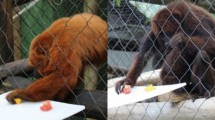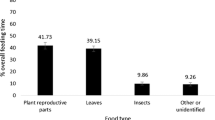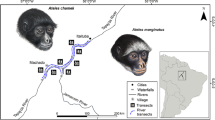Abstract
In order to understand dietary differentiation among frugivorous primates with simple stomachs, we present the first comparison of plant diets between chimpanzees and cercopithecine monkeys that controls for food abundance. Our aim was to test the hypothesis that monkeys have a more diverse diet as a result of their dietary tolerance for chemical antifeedants. Our study species are chimpanzees, blue monkeys, redtail monkeys, and gray-cheeked mangabeys living in overlapping ranges in Kibale National Park, Uganda. We indexed food abundance by the percentage of trees having ripe fruit within the range of each group; it varied widely during the year. Chimpanzees spent almost 3 times as much of their feeding time eating ripe fruits as the monkeys did and confined their diets almost exclusively to ripe fruits when they were abundant. Monkeys maintained a diverse diet at all times. When ripe fruit was scarce chimpanzee and monkey diets diverged. Chimpanzees relied on piths as their main fallback food, whereas monkeys turned to unripe fruits and seeds. For each primate group we calculated the total weighted mean intake of 5 antifeedants; condensed tannins (CT), total tannins assayed by radial diffusion (RD), monoterpenoids (MT), triterpenoids (TT), and neutral-detergent fiber (NDF). Monkeys had absolutely higher intakes of CT, RD, MT, and TT than those of chimpanzees, and their intake of NDF did not differ from that of chimpanzees, appearing relatively high given their lower body weights. However contrary to expectation, dietary divergence during fruit scarcity was not associated with any change in absolute or relative intake of antifeedants. For example, fruit scarcity did not affect the relative intake of antifeedants by cercopithecines compared to chimpanzees. Our results establish chimpanzees as ripe-fruit specialists, whereas cercopithecines are generalists with a higher intake of antifeedants. The low representation of ripe fruits in the diets of cercopithecines has not been explained. An important next step is to test the hypothesis that the difference between Kibale chimpanzees and cercopithecines represents a more general difference between apes and monkeys.
Similar content being viewed by others
REFERENCES
Aiello, L. C., and Wheeler, P. (1995). The expensive-tissue hypothesis: The brain and the digestive system in human and primate evolution. Curr. Anthropol. 36: 199–221.
Andrews, P. J. (1981). Species diversity and diet in monkeys and apes during the Miocene. In Stringer, C. B. (ed.), Aspects of Human Evolution, Taylor and Francis, London, pp. 25–41.
Basuta, G. I. (1989). Feeding ecology of chimpanzees in the Kibale Forest, Uganda. In Heltne, P. G., and Marquardt, L. A. (eds.), Understanding Chimpanzees, Harvard University Press, Cambridge, MA, pp. 116–127.
Butynski, T. M. (1990). Comparative ecology of blue monkeys (Cercopithecus mitis) in high-and low-density subpopulations. Ecol. Monog. 60: 1–26.
Calvert, J. J. (1985). Food selection by western gorillas (G. g. gorilla) in relationship to food chemistry. Oecologia 65: 236–246.
Chapman, C. A., and Wrangham, R. W. (1993). Range use of the forest chimpanzees of Kibale: implications for the understanding of chimpanzee social organization. Am. J. Primatol 31: 263–273.
Chapman, C. A., White, F., and Wrangham, R. W. (1994). Party composition and tree-fruit parameters in chimpanzees and bonobos. In Wrangham, R. W., McGrew, W. C., de Waal, F. B., and Heltne, P. G. (eds.) Chimpanzee Cultures, Harvard University Press, Cambridge, MA, pp. 41–58.
Chapman, C. A., Wrangham, R. W., and Chapman, L. J. (1995). Ecological constraints on group size: an analysis of spider monkey and chimpanzee subgroups. Behav. Ecol. Sociobiol. 32: 199–209.
Clutton-Brock, T. H. (1977). Some aspects of intraspecific variation in feeding and ranging behaviour in primates. In Clutton-Brock, T. H. (ed.) Primate Ecology: Studies of Feeding and Ranging in Lemurs, Monkeys, and Apes, Academic Press, London, pp. 539–556.
Clutton-Brock, T. H., and Harvey, P. H. (1979). Home range size, population density and phylogeny in primates. In Bernstein, I. S., and Smith, E. O. (eds.), Primate Ecology and Human Origins, Garland Press, New York, pp. 201–214.
Conklin, N. L., and Wrangham, R. W. (1994). The value of figs to a hind-gut fermenting frugivore: A nutritional analysis. Biochem. Syst. Ecol. 22:137–151.
Conklin-Brittain, N. L., Wrangham, R. W., and Hunt, K. D. (1998). Dietary response of chimpanzees and cercopithecines to seasonal variation in fruit abundance. II. Macronutrients. Int. J. Primatol. 19: 971–997.
Cords, M. (1986). Interspecific and intracpecific variation in diet of 2 forest guenons, Cercopithecus ascanius and C. mitis. J. Anim. Ecol. 55: 811–827.
Cords, M. (1987). Mixed-Species Association of Cercopithecus Monkeys in the Kakamega Forest, Kenya, University of California Publications in Zoology, Vol. 117.
Davies, A. G., Bennett, E. L., and Waterman, P. G. (1988). Food selection by two South-East Asian colobine monkeys (Presbytis rubicunda and Presbytis melalophos) in relation to plant chemistry. Biol. J. Linn. Soc. 34: 33–56.
Freeland, W. J., and Saladin, L. R. (1988). Choice of mixed diets by herbivores: The idiosyncratic effects of plant secondary compounds. Biochem. Syst. Ecol. 17: 493–497.
Ganzhorn, J. U. (1988). Food partitioning among Malagasy primates. Oecologia 75: 436–450.
Ganzhorn, J. U. (1989). Primate species separation in relation to secondary plant chemicals. Hum. Evol. 4: 125–132.
Gaulin, S. J. C., and Konner, M. (1977). On the natural diet of primates, including humans. In Wurtman, R. and Wurtman, J. (eds.), Nutrition and the Brain, Vol. 1, Raven Press, New York, pp. 1–86.
Gautier-Hion, A. (1980). Seasonal variations of diet related to species and sex in a community of Cercopithecus monkeys. J. Anim. Ecol. 49: 237–269.
Gershenzon, J., and Croteau, R. (1991). Terpenoids. In Rosenthal, G. A., and Berenbaum, M. R. (eds.) Herbivores, Their Interactions With Secondary Plant Metabolites. Vol. 1. The Chemical Participants, Academic Press, San Diego, pp. 165–219.
Ghiglieri, M. P. (1984). The Chimpanzees of Kibale Forest, Columbia University Press, New York.
Glander, K. E. (1982). The impact of plant secondary compounds on primate feeding behavior. Yrbk. Phys. Anthropol. 25: 1–18.
Guillotin, M., Dubost, G., and Sabatier, D. (1994). Food choice and food competition among the three major primate species of French Guiana. J. Zool. (Lond.) 233: 551–579.
Hagerman, A. E. (1987). Radial diffusion method for determining tannin in plant extracts. J. Chem. Ecol. 13: 437–449.
Harborne, J. B. (1993). Introduction to Ecological Biochemistry, 4th ed., Academic Press, London.
Kay, R. F. (1984). On the use of anatomical features to infer foraging behavior in extinct primates. In Rodman, P. S., and J. G. H. Cant (eds.), Adaptations for Foraging in Nonhuman Primates: Contributions to an Organismal Biology of Prosimians, Monkeys and Apes, Columbia University Press, New York, pp. 21–53.
Kay, R. F., and Hylander, W. L. (1978). The dental structure of mammalian folivores with special reference to Primates and Phalangeroidea (Marsupialia). In Montgomery, G. G. (ed.), The Biology of Arboreal Folivores, Smithsonian Institution Press, Washington, DC, pp. 173–191.
Kerbis Peterhans, J., Wrangham, R. W., Carter, M. L., and Hauser, M. D. (1994). A contribution to tropical rain forest taphonomy: Retrieval and documentation of chimpanzee remains from Kibale Forest, Uganda. J. Hum. Evol. 25: 485–514.
Kingsbury, J. M. (1978). Ecology of poisoning. In Keeler, R. F., Van Kampen, K. R., and James, L. F. (eds.), Effects of Poisonous Plants on Livestock, Academic Press, New York.
Kinzey, W. G., and Norconk, M. A. (1993). Physical and chemical properties of fruit and seeds eaten by Pithecia and Chiropotes in Surinam and Venequela. Int. J. Primatol. 14: 207–227.
Leighton, M. (1993). Modeling dietary selectivity by Bornean orangutans: evidence for integration of multiple criteria in fruit selection. Int. J. Primatol. 14: 257–313.
Lindroth, R. L. (1989). Mammalian herbivore-plant interactions. In Abrahamson, W. G. (ed.), Plant-Animal Interactions, McGraw-Hill, New York, pp 163–206.
Maisels, F. (1993). Gut passage rate in guenons and mangabeys: Another indicator of a flexible feeding niche? Folia Primatol. 61: 35–37.
Marks, D. L., Swain, T., Goldstein, S., Richard, A., and Leighton, M. (1988). Chemical correlates of rhesus monkey food choice: The influence of hydrolyzable tannins. J. Chem. Ecol. 14: 213–235.
McKey, D. B., Gartlan, J. S., Waterman, P. G., and Choo, G. M. (1981). Food selection by black colobus monkeys (Colobus satanas) in relation to plant chemistry. Biol. J. Linn. Soc. 16: 115–146.
Milton, K. (1979). Factors influencing leaf choice by howler monkeys: A test of some hypotheses of food selection by generalist herbivores. Am. Nat. 114: 362–378.
Milton, K. (1980). The Foraging Strategy of Howler Monkeys, Columbia University Press, New York.
Milton, K., and Demment, M. W. (1988). Chimpanzees fed high and low fiber diets and comparison with human data. J. Nutr. 118: 1082–1088.
Mole, S., Butler, L. G., and Iason, G. (1990). Defense against dietary tannin in herbivores: A survey for proline-rich salivary proteins in mammals. Biochem. Syst. Ecol. 18: 287–293.
Oates, J. F., Swain, T., and Zantovska, J. (1977). Secondary compounds and food selection by colobus monkeys. Biochem. Syst. Ecol. 5: 317–321.
Oates, J. F., Waterman, P. G., and Choo, G. M. (1980). Food selection by the south Indian leaf-monkey, Presbytis johnii, in relation to leaf chemistry. Oecologia 45: 45–56.
Provenza, F. D., and Cincotta, R. P. (1993). Foraging as a self-organizational learning process: accepting adaptability at the expense of predictability. In Hughes, R. N. (ed.) Diet Selection: An Interdisciplinary Approach to Foraging Behaviour, Blackwell Scientific Publications, Oxford, pp. 78–101.
Rogers, M. E., Maisels, F., Williamson, E. A., Tutin, C. E. G., and Fernandez, M. (1992). Nutritional aspects of Gorilla food choice in the Lopé reserve, Gabon. In Matano, S., Tuttle, R. H., Ishida, H., and Goodman, M. (eds.), Topics in Primatology, University of Tokyo Press, Tokyo, pp. 255–266.
Rolls, E. T., Critchley, H. D., Wakeman, E. A., and Mason, R. (1996). Responses of neurons in the primate taste cortex to the glutamate ion and to inosine 5′-monophosphate. Physiol. Behav., 59: 991–1000.
Rudran, R. (1978a). Socioecology of the blue monkeys (Cercopithecus mitis stuhlmanni) of the Kibale Forest, Uganda. Smithsonian Contributions to Zoology, Smithsonian Institute Press, Washington, DC, Vol. 249, pp. 1–88.
Rudran, R. (1978b). Intergroup dietary comparisons and folivorous tendencies of two groups of blue monkeys (Cercopithecus mitis stuhlmanni). In Montgomery, G. G. (ed.), The Ecology of Arboreal Folivores, Smithsonian Institute Press, Washington, DC, pp. 483–503.
Struhsaker, T. T. (1978). Food habits of five monkey species in the Kibale Forest, Uganda. In Chivers, D. J., and Herbert, J. (eds.), Recent Advances in Primatology, Vol. 1., Academic Press, New York, pp. 225–248.
Struhsaker, T. T. (1980). Comparison of the behaviour and ecology of red colobus and redtail monkeys in the Kibale Forest, Uganda. Afr. J. Ecol. 18:33–51.
Struhsaker T. T., and Leland, L. (1979). Sociobiology of five sympatric monkey species in Kibale forest, Uganda. Adv. Study Behav. 9:159–227.
Temerin, L. A., and Cant, J. G. H. (1983). The evolutionary divergence of old world monkeys and apes. Am. Nat. 122(3): 335–351.
van Soest, P. J. (1994). Nutritional Ecology of the Ruminant, Cornell University Press, Ithaca, NY.
Waser, P. M. (1975). Monthly variations in feeding and activity patterns of the mangabey, Cercocebus albigena. E. Afr. Wild. J. 13: 249–263.
Waser, P. M. (1976). Cercocebus albigena: site attachment, avoidance, and intergroup spacing. Am. Nat. 110: 911–935.
Waser, P. M. (1977). Feeding, ranging, and group size in the mangabey Cercocebus albigena. In Clutton-Brock, T. H. (ed), Primate Ecology, Academic Press, London, pp. 183–222.
Waser. P. M. (1987). Interactions among primate species. In Smuts, B. B., Cheney, D. L., Seyfarth, R. M., Wrangham, R. W., and Struhsaker, T. T. (eds.), Primate Societies, Chicago University Press, Chicago, pp. 210–226.
Waterman, P. G., Mbi, C. N., McKey, D. B., and Gartlan, J. S. (1980). African rainforest vegetation and rumen microbes: Phenolic compounds and nutrients as correlates of digestibility Oecol. 47: 22–33.
Wrangham, R. W. (1980). An ecological model of female-bonded primate groups. Behaviour 75: 262–299.
Wrangham, R. W., and Waterman, P. G. (1983). Condensed tannins in fruits eaten by chimpanzees. Biotropica 15: 217–233.
Wrangham, R. W., Conklin, N. L., Chapman, C. A., and Hunt, K. D. (1991). The significance of fibrous foods for Kibale Forest chimpanzees. Phil. Trans. R. Soc. Lond. B 334: 171–178.
Wrangham, R. W., Chapman, C. A., Clark, A. P., and Isabirye-Basuta, G. (1996). Social ecology of Kanyawara chimpanzees: Implications for understanding the costs of great ape groups. In McGrew, W. C., Marchant, L. F., and Nishida, T. (eds.), Great Ape Societies, Cambridge University Press, Cambridge, pp.45–57.
Author information
Authors and Affiliations
Rights and permissions
About this article
Cite this article
Wrangham, R.W., Conklin-Brittain, N.L. & Hunt, K.D. Dietary Response of Chimpanzees and Cercopithecines to Seasonal Variation in Fruit Abundance. I. Antifeedants. International Journal of Primatology 19, 949–970 (1998). https://doi.org/10.1023/A:1020318102257
Issue Date:
DOI: https://doi.org/10.1023/A:1020318102257




